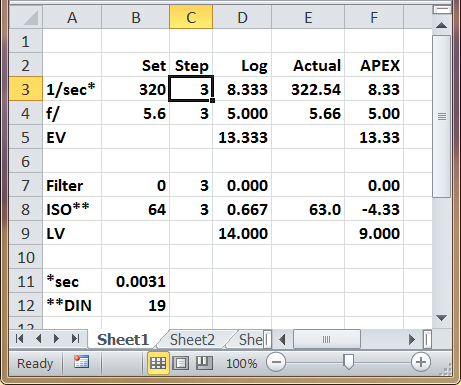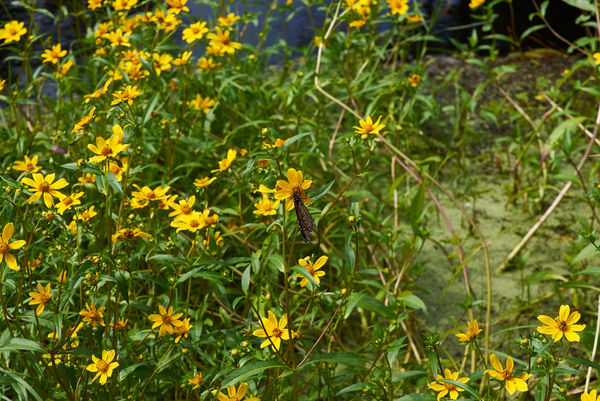Auto ISO
Oct 17, 2019 11:32:41 #
saxman71 wrote:
Don't complicate the thought just because the camera is choosing ISO for you. Matrix (evaluative) metering averages out the brightest/darkest areas to give you a middle of the road exposure regardless of your shooting mode (auto, aperture priority, full manual* etc). ... is the selection of the metering mode an important consideration when using auto ISO?
With spot metering, you have more possibility of a section of the frame being blown out or excessively dark if the light on the scene itself is contrasty.
*assuming you use the camera's recommendation and not your own

Oct 17, 2019 11:34:56 #
Ysarex
Loc: St. Louis
saxman71 wrote:
Thanks for this question Will. It is clear to me that many of the professionals and/or those with considerable experience that shoot wildlife and contribute here use auto ISO regularly. I have had difficulty with it blowing out highlights. However, the last time I experimented with auto ISO I switched from spot to matrix metering and had much better success. Which leads to the question: is the selection of the metering mode an important consideration when using auto ISO?
With auto-ISO engaged the camera will set the ISO to match the camera's metered exposure. It's no more likely to clip highlights than in any other auto or semi-auto mode where the camera is selecting either/or shutter speed and f/stop. That said metering mode matters and spot versus matrix versus average will produce different results. The camera's EC adjustment should still function with the ISO set to auto, but verify that before trusting it as some older model cameras didn't implement EC in manual mode with auto ISO. In manual mode EC of course can't alter exposure (shutter speed and f/stop both user set) and so the engineers disengaged it in full manual. If EC is allowed to adjust ISO with the camera in manual then it's not really EC any more and the control is picking up a different function. This is more commonly implemented today but verify to be sure.
Joe
Oct 17, 2019 11:36:31 #
Speaking about automatic exposure control and except the evaluative metering all of the automation follows rather simple rules so you can know what it would do in any situations. If it's acceptable to you then you can use it.
Oct 17, 2019 11:37:01 #
selmslie wrote:
It' not a philosophical choice.
Bob's right. With auto anything there are lots of situations where the camera's meter gets it wrong.
When you know what you are doing, full Manual is more consistent and safer.
Bob's right. With auto anything there are lots of situations where the camera's meter gets it wrong.
When you know what you are doing, full Manual is more consistent and safer.
I keep looking for a smiley; this is a joke, right?
Oct 17, 2019 11:57:31 #
Strodav
Loc: Houston, Tx
It's another tool that can provide significant advantages when it's called for. It is really helpful when you don't have time to play with settings under varying lighting conditions like when shooting sports and wildlife, especially birding. When you do have the time, like shooting landscapes or portraits with controlled lighting, fix ISO at (or near) base.
If you are in Aperture mode, do you loose control over shutter speed or if you are in shutter speed mode do you loose control over Aperture? No. You just have to keep an eye on what the camera is doing for you and adjust appropriately. My passion is birding and I usually shoot in manual mode with auto ISO from base to 1600. That way I can specifically control subject motion and background blur yet shoot quickly from sun to shade and partly cloudy situations. Again, just another powerful tool in the tool belt if used correctly can make you a better photographer.
If you are in Aperture mode, do you loose control over shutter speed or if you are in shutter speed mode do you loose control over Aperture? No. You just have to keep an eye on what the camera is doing for you and adjust appropriately. My passion is birding and I usually shoot in manual mode with auto ISO from base to 1600. That way I can specifically control subject motion and background blur yet shoot quickly from sun to shade and partly cloudy situations. Again, just another powerful tool in the tool belt if used correctly can make you a better photographer.
Oct 17, 2019 11:59:43 #
Oct 17, 2019 12:14:32 #
sandiegosteve
Loc: San Diego, CA
Auto ISO is a tool. I learned how to use it, and now I use it when it is the best choice.
It can make "mistakes" because it goes off what your metering mode sees. I like Auto ISO with matrix metering. If I am shooting into the sun, I need to dial in some + exposure compensation. It isn't just set it and forget it. I periodically check by looking at the blinkies to makes sure I'm not blowing too much out.
I like it a lot in two situations. 1) Action with inconsistent lighting. Also known as a sports field in daylight or under lights. Daylight you get shadows which can vary over a stop and at night... well lights have hot spots. 2) street type photography when your're moving in and out of lighting conditions.
Force yourself to try it a few times around the garden. Then, once you understand its quirks, you will be more confident when to use it.
It can make "mistakes" because it goes off what your metering mode sees. I like Auto ISO with matrix metering. If I am shooting into the sun, I need to dial in some + exposure compensation. It isn't just set it and forget it. I periodically check by looking at the blinkies to makes sure I'm not blowing too much out.
I like it a lot in two situations. 1) Action with inconsistent lighting. Also known as a sports field in daylight or under lights. Daylight you get shadows which can vary over a stop and at night... well lights have hot spots. 2) street type photography when your're moving in and out of lighting conditions.
Force yourself to try it a few times around the garden. Then, once you understand its quirks, you will be more confident when to use it.
Oct 17, 2019 12:20:42 #
kmpankopf
Loc: Mid-Michigan; SW Pennsylvania
Bob Mevis wrote:
I often use it on my D500.
I'm a big believer in AUTO ISO. I have limits set to prevent a disaster, but if I did my homework right a disaster is not in the cards. I like controlling, or at least knowing my speed and aperture. And that's me, my choice. Between ACR and Topaz DeNoise, I can 'help' a slightly noisy image. Can't fix a miss on speed of DOF.
There are time when a low ISO is critical, and in those cases I adjust. (Know your equipment.) But the default out the door is MANUAL mode w/ISO (AUTO).
Oct 17, 2019 14:07:38 #
will47 wrote:
I was just doing some reading about Auto ISO. What drawbacks, if any, are encountered by using this on a regular basis?
I routinely shoot auto ISO anymore.
I used to worry about noise at high ISO, I mean I was OCD about ISO noise! But processing software has gotten good at reducing high ISO noise that I can shoot at 12,800 and still get low noise output in my natural light shots.
I do shoot raw 100% of the time, so everything is processed outside them camera.
Oct 17, 2019 14:14:02 #
Ysarex wrote:
... In manual mode EC of course can't alter exposure (shutter speed and f/stop both user set) and so the engineers disengaged it in full manual. ...
It's not fully disengaged.
In full manual EC+/- will not affect the exposure or the ISO but it still affects the camera's meter reading, even if you choose to ignore it.
Oct 17, 2019 14:18:29 #
srt101fan wrote:
I keep looking for a smiley; this is a joke, right?
Not if you understand the relationship between light values and exposure+ISO (aka, the "exposure triangle").
LV 14 - 2/3 stop below Sunny 16

Oct 17, 2019 14:25:35 #
Ysarex
Loc: St. Louis
selmslie wrote:
It's not fully disengaged.
In full manual EC+/- will not affect the exposure or the ISO but it still affects the camera's meter reading, even if you choose to ignore it.
In full manual EC+/- will not affect the exposure or the ISO but it still affects the camera's meter reading, even if you choose to ignore it.
Put that sentence back in context with the one that preceded it and I was referring to some older model cameras. There were different approaches. Nikon for example when in full manual mode did apply an EC adjustment to the meter. Other cameras did not and in some cases like Fuji cameras EC was fully disengaged with the camera in manual mode.
Here's what I said in context and it is correct: "The camera's EC adjustment should still function with the ISO set to auto, but verify that before trusting it as some older model cameras didn't implement EC in manual mode with auto ISO. In manual mode EC of course can't alter exposure (shutter speed and f/stop both user set) and so the engineers disengaged it in full manual."
Joe
Oct 17, 2019 14:33:08 #
selmslie wrote:
It' not a philosophical choice.
Bob's right. With auto anything there are lots of situations where the camera's meter gets it wrong.
When you know what you are doing, full Manual is more consistent and safer.
Bob's right. With auto anything there are lots of situations where the camera's meter gets it wrong.
When you know what you are doing, full Manual is more consistent and safer.
With full manual, tracking a subject in and out shade, it's likely the photographer will get some wrong. You can't react and make adjustments as quickly as today's cameras can do it. While you are adjusting the aperture... Oops ... you also need to focus.
Fortunately we have something for almost every situation.
---
Oct 17, 2019 15:04:01 #
Ysarex wrote:
... There were different approaches. Nikon for example when in full manual mode did apply an EC adjustment to the meter. Other cameras did not and in some cases like Fuji cameras EC was fully disengaged with the camera in manual mode. ...
There are good reasons for doing it either way. The most obvious reason for not doing it is that it may not influence the photographer's choice of exposure+ISO.
Nikon still applies the adjustment to the meter and Sony does not. Probably neither will change their approach to avoid confusing the customer.
Oct 17, 2019 15:16:45 #
Bill_de wrote:
With full manual, tracking a subject in and out shade, it's likely the photographer will get some wrong. You can't react and make adjustments as quickly as today's cameras can do it. While you are adjusting the aperture... Oops ... you also need to focus.
Fortunately we have something for almost every situation.
---
Fortunately we have something for almost every situation.
---
Exactly. Here are a couple of shots taken as though it was full sun (it was slightly darker). Both used the same ISO and got the same PP treatment.
I used a manual focus macro lens and the focus distance was about 4 feet.
If you want to reply, then register here. Registration is free and your account is created instantly, so you can post right away.






